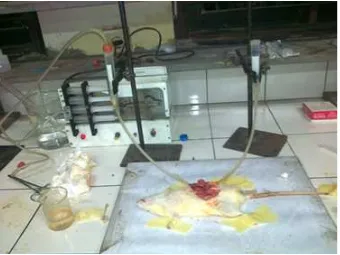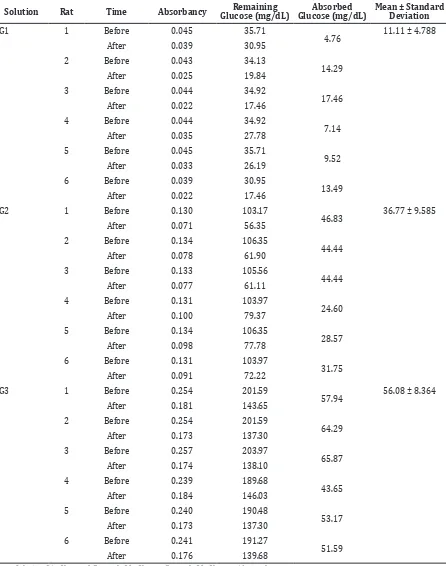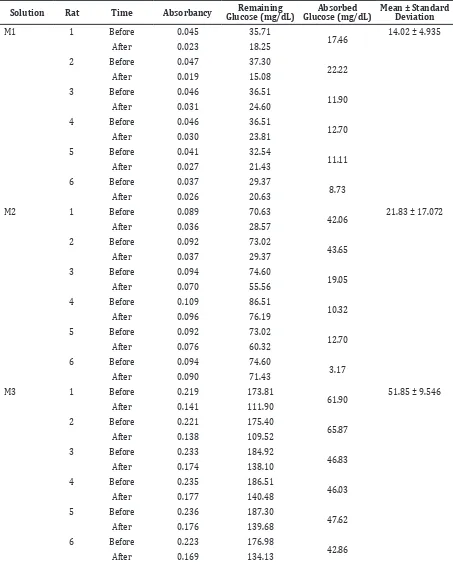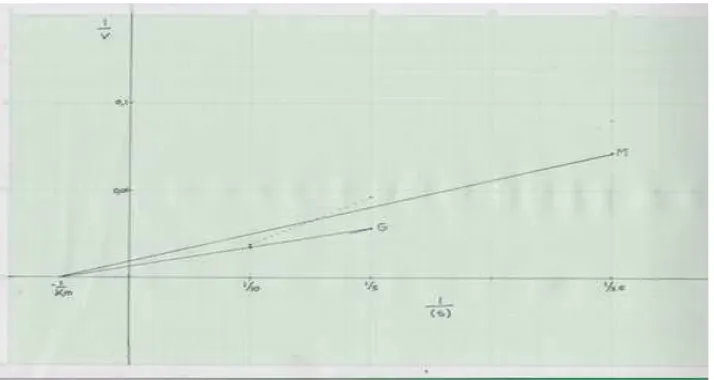546 AMJ December 2017
Effects of Morinda citrifolia Leaf Extract on Glucose Absorption
through Intestinal Epithelial Membrane in Wistar Rat Models
Rikho Melga Shalim,1 Mas Rizky A. Adipurna Syamsunarno,2 Muhammad Nurhalim Shahib2 1Faculty of Medicine Universitas Padjadjaran,
2Department of Biochemistry and Molecular Biology Faculty of Medicine Universitas Padjadjaran
Abstract
Background: Noni fruit (Morinda citrifolia) has been used as herbal medicine by Indonesian people. However, the effect of noni leaves as an antihyperglycemic agent is still unknown. This study was conducted to find out the effect of Morinda citrifolia leaves on glucose absorption through intestinal epithelial membrane in wistar rat models.
Methods: The study was conducted in November 2015 at the Biochemistry and Molecular Biology Laboratory Faculty of Medicine, Universitas Padjadjaran. We used in situ perfusion and rats were divided into 2 groups. The first group used glucose solution as a control. The second group used glucose with extracts. Specimens were taken before and after perfusion to check the amount of glucose with spectrophotometer. Statistical analysis using t-test was conducted to compare the total absorbed concentration of glucose from each group.
Results: From calculation we found the kinetic value (Km) of glucose absorption without extract (Km=17.24)
and with extract (Km=16.67). Statistical test showed there was no significant in results (p>0.05).
Conclusions: There is no effect of Morinda citrifolia leaf extract on glucose absorption. However, kinetics of
glucose absorption suggested a non-competitive inhibition by Morinda citrifolia leaf extract.
Keywords: Antihyperglycemic, glucose absorption, herbal, Morinda citrifolia, transport kinetics
Correspondence: Rikho Melga Shalim, Faculty of Medicine, Universitas Padjadjaran, Jalan Raya Bandung-Sumedang
Km.21, Jatinangor, Sumedang, Indonesia, Email: [email protected]
Introduction
Herbal medicine is a common term for people in Indonesia. Indonesian people use it for therapy purposes such as heart disease,
neuronal problems, and cancer. Studies from
around the world also succeed to prove the effect of herb.1,2 One of the herbs that is commonly used is Noni (Morinda citrifolia). It is a plant that grows well in Indonesia. This plant has many therapeutical effects to be used in medicating diseases.3 However, for years, the use of Noni is more likely from its fruit rather than the other part of it, the leaves. Noni leaves contain alkaloids, saponins, tannins,
flavonoids, steroids, glycosides, and ascorbic
acids.4 Some of them known to have effects to inhibit glucose transport in small intestine.5,6
A study was conducted and proved that
saponins and flavonoids have effects in glucose
transport.7 Nevertheless, the mechanism of how these chemical substances work is yet to be known. In 2010, the World Health
Organization (WHO) found 10% of Indonesian
people have hyperglycemic condition.8 It is a condition when blood glucose is above the normal range. This condition may cause complications that could endanger the person who bears it. Blood glucose rises because of some mechanisms including glucose transport in the small intestine. With intervention to this process, there is a possibility to overcome the hyperglycemic condition. Concentration of glucose that will be absorbed is also a decisive factor in glucose absorption. Therefore, the kinetics of glucose absorption is related to this study.
Furthermore, kinetics of glucose absorption can be determined using a Lineweaver-Burk graph. By use of a millimeter block paper
and scale of axis and ordinate, the researcher
can calculate the kinetics value or
Michaelis-Menten constant (Km). The value of Km reflects the type of inhibition from the extract.9 The
purpose of this study was to find the effects of Morinda citrifolia leaves on glucose absorption through intestine and the kinetics of glucose transport in the small intestine of wistar rat.
Methods
This study was conducted in November 2015 at the Biochemistry and Molecular Biology Laboratory, Faculty of Medicine Universitas Padjadjaran, Jatinangor. Morinda citrifolia leaves were purchased and extracted with
ethanol at the Pharmacy Laboratory of Institut Teknologi Bandung (ITB). The leaves were picked from the middle part of the tree which was 2–3 years old and grown in Coblong,
Bandung. Briefly, they were cut into small
pieces and put in the heating and drying oven.
Then, the dried leaves were mixed with ethanol 70% to undergo the maceration process.
Twelve rats aged twelve to sixteen weeks
old wistar rats with body weight between 200 and 250 grams were adapted for 7 days before
experiment. The Health Research Ethics
Committee Faculty of Medicine, Universitas Padjadjaran has agreed and gave permission to conduct this study with concern to the ethical aspects such as 3R and use of the resource equation method to calculate the number of sample needed.10,11
There were conditions to be met before
the rats were going to the experiment. These conditions were the inclusion and exclusion
criteria. The rats must be in healthy conditions without wounds, and active. There were also
some conditions that excluded the rats to be
used further such as a dropped in weight more
than 10% after the adaptation period and if the rats had been used in an experiment before.
The glucose absorption was measured by in situ perfusion technique to make sure every rat in each group was given the same amount of glucose. Then, the rats were fasted
and anesthetized by Ketamine with dosage of 0.13 mg/100 gram body weight. After the
anesthesia has worked, the abdomen was opened to install cannulas at 10 cm after
pylorus and 25 cm from the first cannula
with a marked string to help measure the
length of intestine. Next step, each cannula
was connected with a rubber tube to bath the intestine with solutions.
Furthermore, the rats were divided into 2
groups. The first group was the control group
which was given glucose solution, while the second group was given glucose with Morinda citrifolia leaf extract solution. The intestine was
perfused with 2.5, 5, and 10 mmol for every 15
minutes with and without leaf extract. Pre and
post perfused solution were collected at the end of perfusion process.
The solutions were mixed with aquadest and trichloroacetic acid (TCA) 8% and centrifuged
for 10 minutes at 3000 rpm. To obtain the best result, the solutions were incubated in 37oC for 10 minutes or at room temperature for 25
548 AMJ December 2017
Table 1 Absorption Data of Control Group
Solution Rat Time Absorbancy Remaining Glucose (mg/dL)
Absorbed Glucose (mg/dL)
Mean ± Standard Deviation
G1 1 Before 0.045 35.71
4.76 11.11 ± 4.788
After 0.039 30.95
2 Before 0.043 34.13
14.29
After 0.025 19.84
3 Before 0.044 34.92
17.46
After 0.022 17.46
4 Before 0.044 34.92
7.14
After 0.035 27.78
5 Before 0.045 35.71
9.52
After 0.033 26.19
6 Before 0.039 30.95
13.49
After 0.022 17.46
G2 1 Before 0.130 103.17
46.83 36.77 ± 9.585
After 0.071 56.35
2 Before 0.134 106.35
44.44
After 0.078 61.90
3 Before 0.133 105.56
44.44
After 0.077 61.11
4 Before 0.131 103.97
24.60
After 0.100 79.37
5 Before 0.134 106.35
28.57
After 0.098 77.78
6 Before 0.131 103.97
31.75
After 0.091 72.22
G3 1 Before 0.254 201.59
57.94 56.08 ± 8.364
After 0.181 143.65
2 Before 0.254 201.59
64.29
After 0.173 137.30
3 Before 0.257 203.97
65.87
After 0.174 138.10
4 Before 0.239 189.68
43.65
After 0.184 146.03
5 Before 0.240 190.48
53.17
After 0.173 137.30
6 Before 0.241 191.27
51.59
After 0.176 139.68
Table 2 Absorption Data of Experimental Group
Solution Rat Time Absorbancy Remaining Glucose (mg/dL)
Absorbed Glucose (mg/dL)
Mean ± Standard Deviation
M1 1 Before 0.045 35.71
17.46 14.02 ± 4.935
After 0.023 18.25
2 Before 0.047 37.30
22.22
After 0.019 15.08
3 Before 0.046 36.51
11.90
After 0.031 24.60
4 Before 0.046 36.51
12.70
After 0.030 23.81
5 Before 0.041 32.54
11.11
After 0.027 21.43
6 Before 0.037 29.37
8.73
After 0.026 20.63
M2 1 Before 0.089 70.63
42.06 21.83 ± 17.072
After 0.036 28.57
2 Before 0.092 73.02
43.65
After 0.037 29.37
3 Before 0.094 74.60
19.05
After 0.070 55.56
4 Before 0.109 86.51
10.32
After 0.096 76.19
5 Before 0.092 73.02
12.70
After 0.076 60.32
6 Before 0.094 74.60
3.17
After 0.090 71.43
M3 1 Before 0.219 173.81
61.90 51.85 ± 9.546
After 0.141 111.90
2 Before 0.221 175.40
65.87
After 0.138 109.52
3 Before 0.233 184.92
46.83
After 0.174 138.10
4 Before 0.235 186.51
46.03
After 0.177 140.48
5 Before 0.236 187.30
47.62
After 0.176 139.68
6 Before 0.223 176.98
42.86
After 0.169 134.13
550 AMJ December 2017
minutes. The absorbance data were analyzed
with the spectrophotometer in 505 nm wave length.
Next, the data were calculated and analyzed
using independent t-test to compare data with and without Morinda citrifolia leaf extract solution, with significant values of p<0.05.
On the other side, kinetics calculation was
not using computerized tools or applications.
This study used a millimeter block paper to
draw a graph of Lineweaver-Burk with 1/S (S=concentration of glucose) on axis and 1/V (V=velocity of absorption which was equal to
the amount of absorbed glucose). There were 2
lines to be drawn, control (G) and experimental
(M). For the axis, 1 smallest square equals to 0.002/mmol, and the ordinate, 1 smallest square equals to 0.0001/mg. Then we took the point of both intersections with axis and use it as a value of -1/Km.
Results
Results from this study showed that in glucose with 2.5 mmol concentration, the addition
of Morinda citrifolia leaf extract was not
providing much difference in the mean of absorbed glucose. In fact, data of the solution
with extract had 2.91 mg/dL more higher
absorbed glucose than the solution without Figure 2 Glucose Concentration
extract (Table 1). A difference was found in
5 mmol of glucose concentration. The mean of absorbed glucose in the control group was
14.94 mg/dL much more than in the group with extract. There was also a difference in 10 mmol glucose concentration with extract,
since the mean of absorbed glucose was 4.23
mg/dL less than in the control group (Table 2).
The rise of glucose absorption following the increase of glucose concentration showed the red line, which represented glucose with
extract, mostly had a position below the blue
one, which represented glucose only solution.
There was no significant effects of Morinda citrifolia leaf extract in glucose absorption
(Figure 2).
Next, we calculated the kinetics of glucose
transport with and without Morinda citrifolia leaves which showed that the one without
additional extract had value of -1/Km=-0.058. Therefore, the Km=17.24. The second, which was glucose with extract, had value of -1/ Km=-0.06 and made the Km=16.67 (Figure 3).
Discussions
Moreover, a statistical test was performed and
found there was not any significant results in
glucose concentration with p value 0.324 (2.5
mmol); 0.091 (5 mmol); and 0.433 (10 mmol).
Although in two concentrations of glucose showed that there were decreases in glucose absorption,the statistical test gave
insignificant results. This may occur with
reasons such as the occurrence of a different antihyperglycemic mechanism. A previous study showed Morinda leaves have two antihyperglicemic mechanisms, by increasing the production of insulin and increasing the
peripheral utilization of glucose.12
There were also limitations in this study. The variety of each rat’s ability to absorb glucose should be considered which took part in varies results. In addition, the insulin also took part in glucose absorption from the cell into bloodstream.13
It can be concluded that there is no effect of Morinda citrifolia leaf extract on intestine
glucose absorption in wistar rats which is shown by statistical test results with p values
>0.05. On the other hand, the kinetic results
show a little difference in Km values, which mean the inhibitor, is not interfered by the glucose transport in the absorption process. We suspect a non-competitive inhibition of intestine glucose absorption by Morinda
citrifolia leaf extract.9
We suggest further studies to investigate
the effects of Morinda citrifolia leaf extract
with higher dosage. Furthermore, a study to develop the kinetic results of glucose transport still needs to be done.
References
1. Agromedia R. Buku pintar tanaman obat: 431 jenis tanaman penggempur aneka
penyakit. Jakarta: Agromedia Pustaka;
2008.
2. Surialaga S, Dhianawaty D, Martiana
A. Efek antihiperkolesterol jus buah
belimbing wuluh (averhoa bilimbi L.) terhadap mencit galur swiss webster hiperkolesterolemia. Majalah Kedokteran
Bandung. 2013;45(2):125–9.
3. Chan-Blanco Y, Vaillant F, Perez AM, Reynes M, Brillouet J-M, Brat P. The noni
fruit (Morinda citrifolia L.): a review of
agricultural research, nutritional and therapeutic properties. J Food Comp Anal.
2006;19(6):645–54.
4. Wardiny TM, Retnani Y, Sinar TEA. Penampilan puyuh starter yang diberi ekstrak daun mengkudu sebagai antibakteri salmonella thypimurium.
Prosiding Seminar Nasional MIPA; 2012. [cited 2016 January 10] Available from: https://ejournal.undiksha.ac.id/index. php/semnasmipa/article/view/2786
5. Castro MA, Angulo C, Brauchi S, Nualart F, Concha, II. Ascorbic acid participates in a general mechanism for concerted glucose transport inhibition and lactate
transport stimulation. Pflugers Arch. 2008;457(2):519–28.
6. El-Tantawy W, Hassanin L. Hypoglycemic and hypolipidemic effects of alcoholic
extract of Tribulus alatus in streptozotocin-induced diabetic rats: a comparative study with T. terrestris (Caltrop). Indian J Exp Biol. 2007;45(9):785-90.
7. Kwon O, Eck P, Chen S, Corpe CP, Lee J-H, Kruhlak M, et al. Inhibition of the intestinal
glucose transporter GLUT2 by flavonoids. FASEB J. 2007;21(2):366–77.
8. Soewondo P, Pramono LA. Prevalence, characteristics, and predictors of pre-diabetes in Indonesia. Med J Indones.
2011;20(4):283-94.
9. Shahib MN. Biologi molekuler medik.
Bandung: P.T. Alumni; 2012.
10. Charan J, Kantharia ND. How to calculate
sample size in animal studies? J Pharmacol Pharmacother. 2013;4(4):303–6.
11. Festing S, Wilkinson R. The ethics of animal
552 AMJ December 2017
12. Adeneye A, Agbaje E. Pharmacological evaluation of oral hypoglycemic and antidiabetic effects of fresh leaves ethanol
extract of Morinda Lucida Benth. in normal and alloxan-induced diabetic rats. Afr J
Biochem Res. 2008;11(1):65–71.
13. Kellett GL, Brot-Laroche E, Mace OJ,



